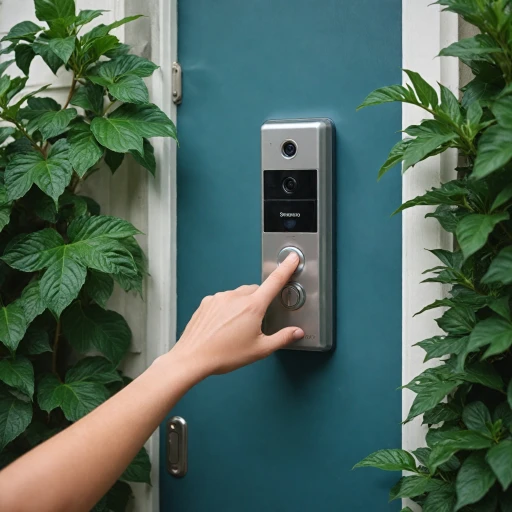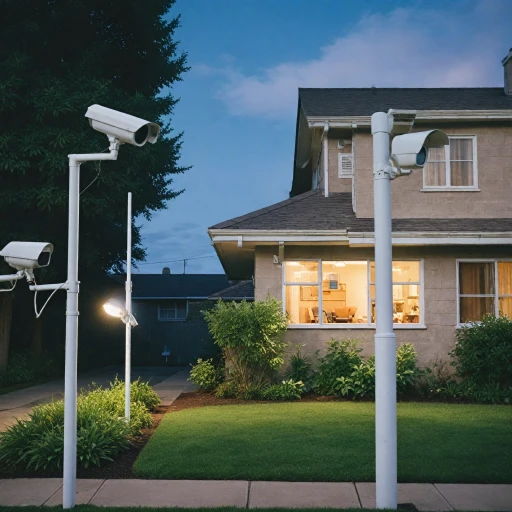
Understanding Your Ring Camera's Wi-Fi Requirements
Knowing Your Ring Camera's Wi-Fi Needs
Before you embark on the journey of connecting your Ring device to the internet, it's essential to understand its specific Wi-Fi requirements. Whether you own a Ring doorbell, stick cam, or video doorbell, ensuring compatibility with your Wi-Fi network is crucial for seamless connection and operation.
When considering your Ring camera's connection to Wi-Fi, take note of the following:
- Your router must support a 2.4GHz band, as most Ring devices connect better on this frequency due to its broader range compared to the 5GHz band.
- Ensure your network's SSID is visible. Hidden networks can sometimes lead to connection issues and troubleshooting headaches.
- Have your Wi-Fi password handy. Double check its accuracy as incorrect credentials can prevent the ring doorbell from connecting properly.
- The position of your router relative to your Ring camera can significantly impact the strength of your internet connection. A closer proximity and fewer obstructions will lead to better performance.
For a comprehensive step-by-step approach to getting your Ring camera online, visit our in-depth ring doorbell setup guide.
Understanding these foundational requirements will lay a solid base as you advance through the succeeding sections, where you'll prepare your network for connection, connect your device seamlessly, and address potential connectivity roadblocks.
Preparing Your Network for Connection
Setting the Stage for a Successful Ring Connection
Before you can seamlessly connect your Ring devices, such as the video doorbell or stick cam, to the Wi-Fi network, it's critical to prepare your network infrastructure suitably. Ensuring that your router and Wi-Fi settings are optimally configured will pave the way for smooth operation and a robust internet connection.- Check Wi-Fi Compatibility: Ensure your network will support the type of connection your Ring device requires. Generally, Ring cameras work best with a 2.4 GHz Wi-Fi network, although some models also support 5 GHz. Be sure to confirm your router's specifications match the Ring camera's requirements.
- Network Name and Password: Closely adhere to your network's SSID (Service Set Identifier) and Wi-Fi password. These must be accurate for the device to connect to the network. It's recommended to use a strong and unique password to enhance security, considering changing your password from what you set up months ago.
- Proximity to Router: Position your Ring camera, whether a white base station or stick cam, within a reasonable proximity to your router. Walls and large objects can impede signal strength, which could affect the device's performance. When looking for the optimal location, use trial and error to find the best results.
- Router Settings: Verify that your router supports wireless connections and that there's an internet connection available. Make sure your router settings do not inadvertently block your Ring devices by checking any parental controls or access restrictions in place.
- Firmware Updates: Updating your router can resolve common issues that might prevent your Ring device from connecting. Regularly update to the latest firmware version provided by your router manufacturer.
Step-by-Step Guide to Connecting Your Ring Camera to Wi-Fi
Connecting Your Ring Camera: A Simple Walkthrough
The process to connect your Ring device, whether it's a video doorbell or a stick cam, to your Wi-Fi network can be straightforward when you follow a few easy steps.- Begin with the App: Open the Ring app on your smartphone. If you’ve recently updated or downloaded it, ensure you have the latest version for optimal support. On the home screen, locate the "Setup Device" option. This will guide you to add your new Ring device.
- Select Your Device Type: Whether it’s a video doorbell or another type of Ring device, the app will prompt you. Here, you need to select the type of Ring device you’re setting up. Choosing the correct device streamlines the process.
- Power Up Your Device: Most ring devices, like the doorbell or stick cam, have a power button or require you to plug them in. Look for a small white power icon or light, which generally signals that the device is on and ready to connect.
- Connecting to Wi-Fi: On the Ring app, tap "Select a Wi-Fi Network" or a similar option. Your goal here is to connect your Ring device to your home Wi-Fi network. When prompted, input your Wi-Fi password. For security and to avoid issues, ensure that your chosen network is steady and within range.
- Base Station and Routers: If you're using a base station, like with some Ring security systems, make sure it's powered and ready. Your router settings might influence the connection strength, so it helps to place your device within a reasonable distance.
- Notifications and Confirmation: After entering your Wi-Fi details, the app will attempt to connect your device. Pay attention to any messages the app might display — these usually notify you if your device connects successfully or if there’s an issue needing attention.
Troubleshooting Common Connection Issues
Troubleshooting Connectivity for Your Ring Device
Encountering issues while trying to connect your Ring camera to Wi-Fi can be frustrating, yet these are typically resolvable with a few strategic steps. Understanding the key areas to inspect will help in resolving these issues effectively.- Verify Wi-Fi Credentials: Ensure that the Wi-Fi password you are using matches the credentials for your network. A simple typo can prevent your Ring device from connecting. It's essential to double-check this information.
- Router Placement and Frequency: The location of your router can greatly impact the connection. Ensure your router is positioned centrally to your Ring devices for optimal connectivity. Additionally, some routers offer dual-band support. If you have not done so, try both 2.4GHz and 5GHz frequencies.
- Check for Interference: Other electronic devices can sometimes interfere with Wi-Fi signals. Reduce interference by moving any potential obstructions or frequency-emitting devices away from your Ring doorbell or base station.
- Internet Connection Status: Assess your internet connection. If your network is down or experiencing slow speeds, this will hinder the connection of your Ring camera. Confirm that your internet service is not disrupted.
- Device Proximity and Power: Ensure that your Ring camera is within the recommended distance from the Wi-Fi router. Additionally, check that your device is adequately powered; a low battery can impede connectivity.
- Use Ring App for Guidance: Utilizing the Ring app can help diagnose connection problems. Follow any steps or error messages the app provides, which might give insights into specific issues affecting the device connection.
Enhancing Your Ring Camera's Wi-Fi Performance
Boosting the Signal Strength for Your Ring Camera
To enhance the Wi-Fi performance of your Ring camera and ensure smooth video streaming and reliable connection, consider the following strategies:
- Optimal Router Placement: Position your router in a central location within your home to maximize coverage. Avoid placing it near thick walls or metal objects which can block signal strength.
- Wi-Fi Extenders: If your Ring devices are far from the router, consider using Wi-Fi extenders or a mesh network to broaden your Wi-Fi coverage and reduce dead zones.
- Prioritize your Network: Allocate more bandwidth to your Ring devices by limiting the usage of other bandwidth-heavy applications connected to the same Wi-Fi network.
- Update Router Firmware: Regularly update your router’s firmware to ensure it operates with the latest enhancements and security features.
Utilizing Quality-of-Service (QoS) Settings
Most modern routers support Quality-of-Service settings, allowing you to prioritize internet traffic by device or application. By allocating more bandwidth to the network accommodating your Ring camera, you can maintain stable performance even with multiple devices connected. Refer to your router’s manual for specific configuration instructions.
Choosing the Right Channel and Frequency Band
To reduce interference, select a less congested Wi-Fi channel on your router. Additionally, if your router supports dual band, test if your Ring video doorbell or stick cam would benefit from either the 2.4 GHz or 5 GHz band for more stable connectivity. While 5 GHz offers faster speeds, 2.4 GHz provides greater coverage distance.
Securing Your Wi-Fi Network for Optimal Ring Camera Use
Protecting Your Wi-Fi from Unauthorized Access
To ensure optimal performance of your ring devices and safeguard your privacy, it's crucial to secure your Wi-Fi network. Here are important steps you can follow:- Change Default Router Settings: Most routers come with default admin IDs and passwords. Make sure to update them with unique credentials to prevent unauthorized access. The new admin ID and password will be required whenever you need to make changes to the router settings.
- Enable WPA2 or WPA3 Encryption: Utilize WPA2 or WPA3 encryption on your Wi-Fi network. This technology will connect your Ring camera securely by encrypting the data transferred between devices, making it unreadable to those without the correct Wi-Fi password.
- Regularly Update Your Router's Firmware: Manufacturers periodically release updates to address vulnerabilities. Routinely updating your router will ensure it has the latest security patches and performance improvements.
- Create a Guest Network: If you frequently have visitors at home, setting up a guest network can keep your main network more secure. It allows your guests to access the internet while restricting access to your Ring devices and other connected devices.
- Disable Network Name Broadcasting: By hiding your Wi-Fi network’s SSID, you can add another layer of security. This forces potential intruders to know the exact name of your Wi-Fi network to connect to it. However, remember that this may require manual setup on each device, including your Ring video doorbell and stick cam.
- Monitor Connected Devices: Regularly check the list of devices on your network to ensure that only authorized devices, like your Ring camera and doorbell, are connected. Many routers come with an admin screen select option where you can view and manage connections.
- Educate Users in Your Household: Make sure all users are aware of best practices for Wi-Fi security. Encourage them to report any unusual activity or unauthorized messages they might notice.












